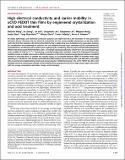High electrical conductivity and carrier mobility in oCVD PEDOT thin films by engineered crystallization and acid treatment
Author(s)
Wang, Xiaoxue; Zhang, Xu; Sun, Lei; Lee, Dongwook; Lee, Sunghwan; Wang, Minghui; Zhao, Junjie; Shao-Horn, Yang; Dinca, Mircea; Palacios, Tomas; Gleason, Karen K; ... Show more Show less
Downloadeaat5780.full.pdf (1.332Mb)
PUBLISHER_CC
Publisher with Creative Commons License
Creative Commons Attribution
Terms of use
Metadata
Show full item recordAbstract
Air-stable, lightweight, and electrically conductive polymers are highly desired as the electrodes for next-generation electronic devices. However, the low electrical conductivity and low carrier mobility of polymers are the key bottlenecks that limit their adoption.We demonstrate that the key to addressing these limitations is tomolecularly engineer the crystallization and morphology of polymers. We use oxidative chemical vapor deposition (oCVD) and hydrobromic acid treatment as an effective tool to achieve such engineering for conducting polymer poly(3,4-ethylenedioxythiophene) (PEDOT). We demonstrate PEDOT thin filmswith a record-high electrical conductivity of 6259 S/cm and a remarkably high carriermobility of 18.45 cm2V-1s-1by inducing a crystallite-configuration transition using oCVD. Subsequent theoretical modeling reveals a metallic nature and an effective reduction of the carrier transport energy barrier between crystallized domains in these thin films. To validate this metallic nature, we successfully fabricate PEDOT-Si Schottky diode arrays operating at 13.56MHzfor radio frequency identification (RFID) readers, demonstratingwafer-scale fabrication compatible with conventional complementary metal-oxide semiconductor (CMOS) technology. The oCVD PEDOT thin films with ultrahigh electrical conductivity and high carrier mobility show great promise for novel high-speed organic electronics with low energy consumption and better charge carrier transport.
Date issued
2018-09Department
Massachusetts Institute of Technology. Department of Chemical Engineering; Massachusetts Institute of Technology. Department of Chemistry; Massachusetts Institute of Technology. Department of Electrical Engineering and Computer Science; Massachusetts Institute of Technology. Department of Materials Science and Engineering; Massachusetts Institute of Technology. Department of Mechanical EngineeringJournal
Science Advances
Publisher
American Association for the Advancement of Science (AAAS)
Citation
Wang, Xiaoxue, Xu Zhang, Lei Sun, Dongwook Lee, Sunghwan Lee, Minghui Wang, Junjie Zhao, et al. “High Electrical Conductivity and Carrier Mobility in oCVD PEDOT Thin Films by Engineered Crystallization and Acid Treatment.” Science Advances 4, no. 9 (September 2018): eaat5780.
Version: Final published version
ISSN
2375-2548